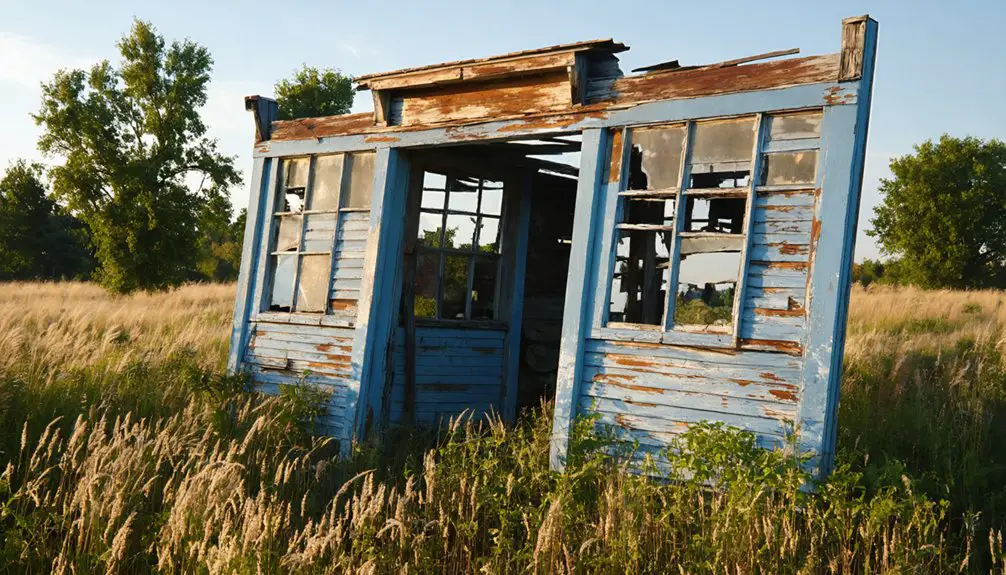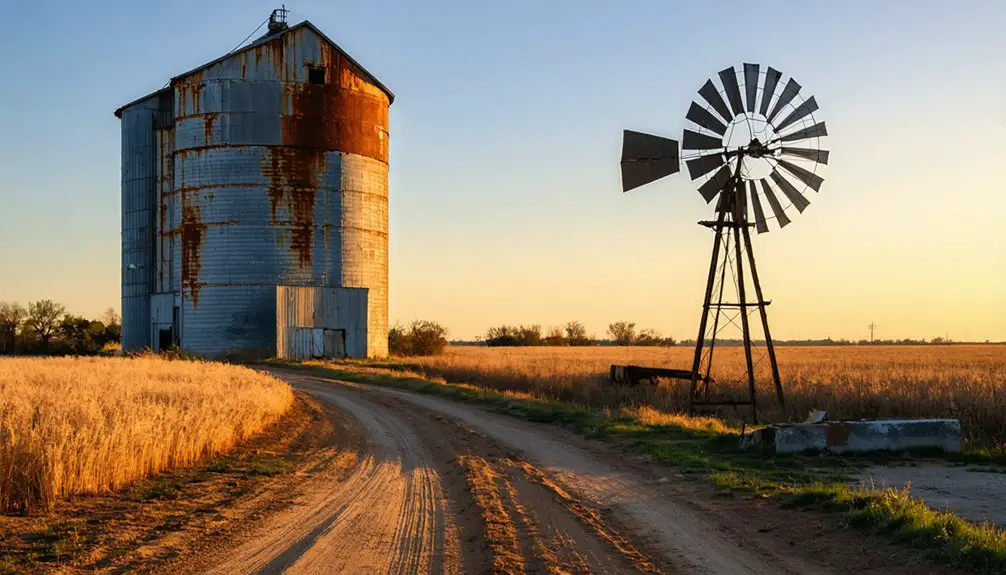You’ll find the ghost town of Gee in Pushmataha County, Oklahoma, where Henry V. Gee established a post office on May 22, 1909. As the town’s namesake and first postmaster, Gee helped create a brief but vibrant frontier community that served local settlers and Native American residents. The post office closed on November 30, 1911, and the town quickly faded. Today, GPS coordinates help locate this lost settlement, where remnants of Oklahoma’s pioneer spirit still echo through time.
Key Takeaways
- Gee was a short-lived Oklahoma settlement with a post office operating from 1909 to 1911 under postmaster Henry V. Gee.
- Located at N35 59.268′ W95 08.188′ in Cherokee County, Gee is now a ghost town amid mixed deciduous forests.
- The community’s decline paralleled its post office closure in 1911, with mail services redirected to neighboring towns.
- Henry V. Gee, the town’s namesake and first postmaster, is buried in nearby Nolia’s cemetery.
- The settlement struggled due to isolation from major transportation routes and relied heavily on Clayton for supplies.
The Brief Life of a Frontier Post Office
When settlers established the town of Gee in Pushmataha County, Oklahoma, they gained their own post office on May 22, 1909, with Henry V. Gee serving as the first postmaster.
You’ll find it was located 11 miles southeast of Clayton, within the Choctaw Nation‘s boundaries. Like many early post offices in the region, it was soon consolidated with neighboring facilities.
The post office operations proved essential yet short-lived for this frontier community. For just over two years, it served as your primary hub for rural communication, connecting you to the outside world through mail services and news delivery. The name “Gee” follows the phonetic pronunciation rule, representing the letter G in the English alphabet.
You’d have found it crucial for staying in touch with family, conducting business, and receiving goods in this remote area. The facility closed its doors on November 30, 1911, marking the end of independent postal services in Gee, with mail routing shifted to nearby communities.
Henry V. Gee’s Legacy in Pushmataha County
Behind the founding of Gee, Oklahoma, stood Henry V. Gee (1868-1916), who served as the first postmaster of this frontier settlement. You’ll find his influence preserved in the community’s name, which operated its post office from May 1909 to November 1911.
Located 11 miles southeast of Clayton, the Gee community emerged during Oklahoma’s early statehood period, when the region was evolving from Choctaw Nation territory. The area’s rich timber resources made it an ideal location within the Ouachita Mountains region. The site was established shortly after Clayton’s name change from Dexter in 1907.
While the town no longer exists today, Henry Gee’s legacy lives on through postal records and local histories. His final resting place in nearby Nolia’s cemetery stands as a demonstration of his dedication to the area.
Though brief, the Gee community’s existence reflects the pioneering spirit of southeastern Oklahoma’s early settlers.
Early Settlement and Community Development
As Oklahoma emerged from its territorial status in the early 20th century, the rural community of Gee took root in Pushmataha County’s Little River valley region.
You’ll find its origins tied to the establishment of a U.S. Post Office on May 22, 1909, with Henry V. Gee serving as the first postmaster. The settler challenges were significant, as the community lacked major transportation routes and established commerce pathways. Similar to Garlington, which operated its post office until 1926, Gee struggled to maintain a sustainable population base.
The community dynamics reflected a blend of Native American descendants and settlers, creating a unique social fabric within the Choctaw Nation territories. Like many early ghost towns, Gee’s decline was linked to resource limitations and urbanization.
Despite its promising start, Gee’s infrastructure remained limited to the post office, which closed by November 30, 1911. The settlement’s residents relied heavily on nearby Clayton, 11 miles northwest, for additional services and supplies.
Location and Geographic Features
The ghost town of Gee rests at latitude N35 59.268′ and longitude W95 08.188′, approximately 4 miles north of Hulbert on N4420 Road in eastern Oklahoma.
Hidden in eastern Oklahoma’s rural expanse, Gee’s ghost town remains frozen in time at N35 59.268′ W95 08.188′
You’ll find it nestled in the gently rolling hills of Cherokee County, where the geographic significance of its location showcases the shift between the Ozark Plateau foothills and native grasslands.
The area’s environmental impact remains minimal, with mixed deciduous forests and grasslands thriving at elevations between 700-800 feet.
You’ll need to navigate gravel and lightly paved roads to reach the site, where sandy loam soils once supported small farms. Modern GPS waypoints systems have made locating these remote ghost towns much easier for explorers. Like many rural settlements, Gee declined when transportation routes changed in the region.
The humid subtropical climate, delivering 40-45 inches of annual rainfall, has preserved many of the town’s remnants in their natural setting, while nearby creeks weave through the landscape.
Oklahoma’s Lost Towns of the Early 1900s
You’ll find Gee’s story mirrors many Oklahoma settlements that emerged during early statehood, when post offices served as anchors for new communities trying to establish themselves.
Like Cloud Chief, which lost its charter and closed its post office in 1964, countless small towns faced terminal decline once their primary institutions shuttered. Railroad companies’ decisions to bypass certain towns in favor of others often spelled doom for these fledgling communities, as happened frequently across Oklahoma in the early 1900s. Towns like Boggy Depot declined rapidly when railway lines bypassed them, shifting trade routes elsewhere.
Post offices, which initially gave these settlements legitimacy and drew residents, would eventually close as populations dwindled, marking the final chapter for towns like Gee that couldn’t sustain themselves without reliable transportation links.
Early Statehood Settlement Patterns
During Oklahoma’s early statehood period, hundreds of small towns sprouted rapidly across the landscape, though many wouldn’t survive more than a few years.
The settlement dynamics were driven by economic opportunities, with communities forming near Native American allotments and along pre-railroad trade routes. You’d find these hopeful settlements anchored by hotels, mills, and saloons, competing fiercely for regional prominence.
Community resilience often hinged on a town’s ability to adapt to rapid changes. When railroads arrived, they’d reshape settlement patterns dramatically, drawing populations away from older locations toward rail-connected hubs.
If your town missed the railroad or couldn’t diversify beyond a single industry, you’d likely witness its swift decline. Many settlements that once bustled with thousands of residents would lose up to 80% of their population, becoming ghost towns.
Railroad Town Life Decline
While Oklahoma’s rail network expanded dramatically from 289 miles in 1880 to over 6,500 miles by 1920, many railroad towns faced devastating decline as transportation patterns shifted.
You’d find that a town’s prosperity hinged entirely on railroad routing decisions, with those left off the rail lines often disappearing entirely. The railroad’s impact reached far beyond just transport – it meant jobs, commerce, and community survival.
- Rail repair shops and depots provided essential employment until their closures hit towns hard.
- Loss of passenger service isolated communities as automobiles took over.
- Towns dependent on oil transport suffered when pipelines replaced rail shipping.
- When key rail facilities closed, like Shawnee’s repair shops in 1937, entire communities lost their economic foundation.
Post-Office Community Development
As Oklahoma’s early settlements took shape in the 1900s, post offices emerged as essential cornerstones of community development. You’d find these significant hubs serving as more than mail stations – they were the beating heart of local commerce and communication, legitimizing settlements and attracting new residents.
The post office strengthened community identity by fostering connections between neighbors and facilitating essential business correspondence. Around these centers, you’d see schools, churches, and stores spring up, creating vibrant social spaces where townspeople gathered to exchange news and conduct daily business.
When communities faced economic challenges or infrastructure changes, like new highway routes bypassing their town, the closure of a post office often marked the beginning of their decline. Many Oklahoma ghost towns still feature these abandoned buildings, silent testimonies to once-thriving communities.
Historical Significance and Documentation

You’ll find Gee’s clearest historical footprint in its postal records, which document the town’s brief but notable existence from 1909 to 1911 under postmaster Henry V. Gee.
The town’s namesake and first postmaster left a lasting mark on local history, with his final resting place in nearby Nolia Cemetery serving as a tangible connection to this early Pushmataha County settlement.
As one of Oklahoma’s numerous ghost towns from the early 1900s, Gee’s documentation through postal archives and cemetery records provides valuable insight into the region’s pioneer settlement patterns.
Postal Records Tell Story
The two-year operation of Gee’s post office from 1909 to 1911 tells a compelling story about this Oklahoma ghost town‘s brief existence. Through postal archives, you’ll discover that Henry V. Gee, the town’s first postmaster and namesake, established this essential community hub during Oklahoma’s early statehood.
The post office’s short lifespan serves as one of the significant economic indicators of the town’s struggle to sustain itself.
- First postmaster Henry V. Gee left his legacy in both name and service
- Post office operations lasted from May 22, 1909, to November 30, 1911
- Records show typical boom-and-bust pattern of early Oklahoma settlements
- Documents preserved by Pushmataha County Historical Society reveal broader regional context
Today, these postal records provide important insights into Gee’s shift from a hopeful settlement to an Oklahoma ghost town.
Local Pioneer Legacy
While pioneer settlements often vanished without leaving much historical record, Gee’s legacy endures through its namesake Henry V. Gee, who served as the community’s first postmaster from 1909 to 1911.
You’ll find his final resting place in Nolia’s cemetery, where he was laid to rest in 1916.
The Pushmataha County Historical Society preserves pioneer traditions through careful documentation of early settlements like Gee.
These archives tell stories of community resilience, showing how pioneers established essential infrastructure in remote areas.
Though Gee’s formal existence was brief, it represents the determination of Oklahoma’s early settlers who shaped the region’s development.
Local historians continue piecing together Gee’s story through post office records, cemetery registries, and oral histories passed down through generations.
Frequently Asked Questions
What Happened to the Residents of Gee After the Town’s Decline?
You’ll find that residents dispersed to nearby towns and cities, following migration patterns shaped by economic opportunities. They showed community resilience by adapting to new locations and maintaining family ties.
Were There Any Schools or Churches Established in Gee?
You won’t find any documented school history or church significance in the town – historical records don’t show evidence of either institution being established during Gee’s brief existence from 1909-1911.
What Types of Businesses or Industries Operated in Gee?
You’d find mining operations fueled much of the town’s economy, with local commerce built around supporting mine workers, including saloons, general stores, and businesses serving railroad traffic.
Did Any Notable Events or Incidents Occur During Gee’s Brief Existence?
Like scrolling through an empty social feed, you won’t find any documented ghost sightings or historical significance during Gee’s existence – no notable events were recorded from 1909 to 1911.
Are There Any Remaining Structures or Artifacts From Gee Today?
You won’t find many remaining artifacts in the area today, as there’s no documented evidence of surviving structures or items of historical significance from this once-inhabited location.
References
- https://en.wikipedia.org/wiki/List_of_ghost_towns_in_Oklahoma
- https://www.youtube.com/watch?v=1stZe7ukjts
- https://en.wikipedia.org/wiki/Gee
- https://echo.snu.edu/the-ghost-towns-of-oklahoma/
- https://www.okhistory.org/publications/enc/entry?entry=GH002
- https://gateway.okhistory.org/ark:/67531/metadc2123449/m2/1/high_res_d/1952-v30-n01_a04.pdf
- https://about.usps.com/who/profile/history/pdf/first-rfd-oklahoma.pdf
- https://okgenweb.net/okprojects/po-index.html
- https://www.history.navy.mil/research/library/online-reading-room/title-list-alphabetically/g/gedunk.html
- https://www.okhistory.org/publications/enc/entry?entry=PU005



